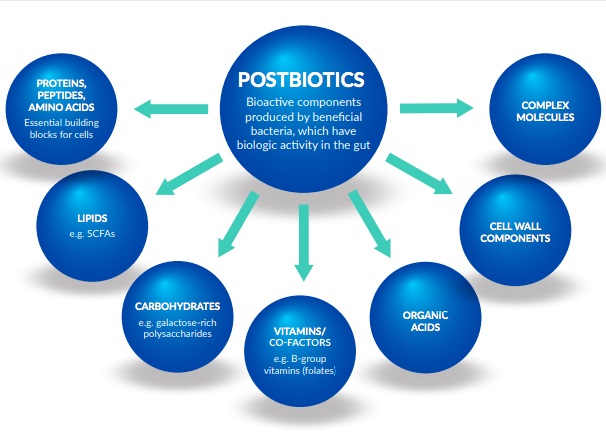- Home
- Blog
- Healthy Eating for Wellness
- What the heck are postbiotics?
What the heck are postbiotics?
Written by Catherine Saxelby
on Wednesday, 14 April 2021.
Tagged: health, healthy eating, healthy lifestyle, nutrition, postbiotics

You’ve probably heard of probiotics, those friendly bacteria that can grow and multiply in our large intestines. You may also have heard of prebiotics, those high-soluble fibres that act as fuel or food for these friendly bacteria. But have you heard of postbiotics and do you know what they are?
Postbiotics – what they are…
According to Wikipedia, postbiotics are defined as “ metabiotics, biogenics or simply metabolites . They are soluble factors (metabolic products or by-products), secreted by live bacteria, or released after bacterial lysis, that provide physiological benefits to the host.” (Lysis meaning when the bacteria cell walls are ruptured and their contents released.)
In other words, postbiotics are produced as by-products of the fermentation process carried out by your microbiome. Examples of postbiotics (and researchers have identified over 800 postbiotic compounds so far) include:
- short-chain fatty acids (SCFAs), such as acetate, butyrate and propionate. These are produced by fermenting undigested carbohydrates in the intestine.
- polysaccharides, including polysaccharide A and exopolysaccharide
- peptides (protein sub-units) such as muramyl dipeptide
- indole, derived from tryptophan
- teichoic acid
- lactocepin
- p40 molecule
- Others include bacteriocins, antimicrobial peptides and hydrogen peroxide.
 Source: courtesy of Medium.com
Source: courtesy of Medium.com
Postbiotics – what they do…
Postbiotics seem to be responsible for many of the beneficial effects of probiotics. They include enzymes, cell surface proteins and vitamins. The short chain fatty acids produced provide a major source of energy for the colon cells and play a role in intestinal differentiation. Postbiotics have been found to possess antioxidative, anticarcinogenic and anti-inflammatory properties and play an essential role in the immune system.
Postbiotics – where you can get them…
The best way to get postbiotics is to have a healthy microbiome and to feed it the fibre it needs. In other words, prebiotics + probiotics produces postbiotics. Check out my 10 easy ways to up your fibre intake here. You can read more about the microbiome here.
You can increase your intake of probiotics by taking one the many commercial preparations available or you can increase your intake of fermented foods which naturally contain probiotic bacteria like kefir, yoghurt, kimchi and sauerkraut.
Postbiotics – do you really need them?
If you want to stay healthy then, yes, you do need them but you get them by having a diet rich in prebiotic fibre and probiotic foods.
The bottom line
We still have a long way to go in completely understanding how these friendly bacteria influence our health and conversely, how we can influence them too. However, understanding these postbiotic compounds may be a big part of the picture.
Foodwatch
The Good Stuff
The Boring Stuff
© 2025 Foodwatch Australia. All rights reserved
Website by Joomstore eCommerce





